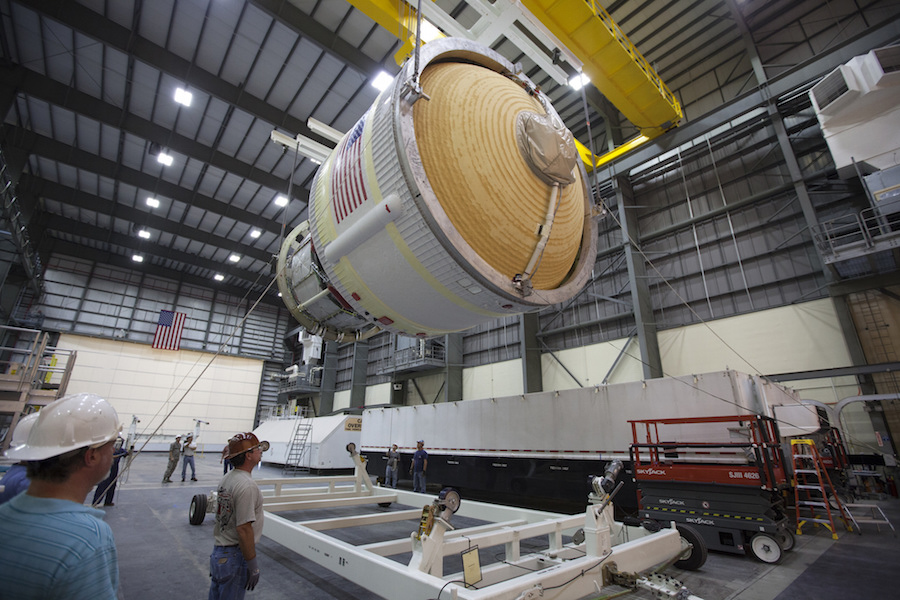Space News & Blog Articles
Citing valve problem, NASA will load only the SLS core stage in next countdown test
 NASA’s Space Launch System on pad 39B at the Kennedy Space Center. Credit: NASA/Joel Kowsky
NASA’s Space Launch System on pad 39B at the Kennedy Space Center. Credit: NASA/Joel Kowsky
A problem with a helium valve on the Space Launch System moon rocket’s upper stage will require ground teams to only partially load the giant launcher with cryogenic propellants during an upcoming countdown dress rehearsal, NASA officials said Saturday.
Instead of fully loading both stages of the rocket cryogenic liquid hydrogen and liquid oxygen, NASA will now focus only on pumping propellants into the core stage, the largest element of the giant launch vehicle.
NASA also confirmed teams now targeting Thursday for the next opportunity to load cryogenic propellants in the Space Launch System moon rocket at the Kennedy Space Center. This is three days later than previously planned.
The “modified” wet dress rehearsal will have “minimal propellant operations” on the SLS interim cryogenic propulsion stage, NASA said in a blog post early Saturday. NASA officials decided Friday to delay the cryogenic tanking operation from Monday to Thursday, but did not announce the decision until early Saturday.
A “call to stations” in the firing room at the Kennedy Space Center is scheduled for Tuesday, leading up to tanking Thursday morning.
“The modified test will enable engineers to achieve the test objectives critical to launch success,” NASA said.
NASA said engineers identified a problematic helium check valve associated with the SLS upper stage, but the agency’s statement did not make it clear whether the valve is on the rocket or on the mobile launch tower at pad 39B. As a result,NASA said it will not fill the upper stage with cryogenic propellants “to ensure safety of the flight hardware.”
The valve is part of the interim cryogenic propulsion stage, but not in the stage’s RL10 engine, according to Madison Tuttle, a NASA spokesperson.
Earlier this week, NASA said it ran into trouble maintaining helium purge pressure on the Aerojet Rocketdyne RL10 engine on the upper stage, following the changeout of a regulator on the mobile launcher structure at the pad. The upper stage itself was built by United Launch Alliance, and is a modified version of the upper stage flown on ULA’s commercial Delta 4-Heavy rocket.
The core stage was manufactured by Boeing, and is powered by four RS-25 engines left over from the space shuttle program.
The entire rocket will contain 755,000 gallons of cryogenic propellants when fully loaded. The upper stage contains 22,000 gallons, and the core stage tanks hold 733,000 gallons.
 The Interim Cryogenic Propulsion Stage, or ICPS, for the first SLS test flight is pictured in 2018 inside United Launch Alliance’s Horizontal Integration Facility at Cape Canaveral. Credit: NASA/Ben Smegelsky
The Interim Cryogenic Propulsion Stage, or ICPS, for the first SLS test flight is pictured in 2018 inside United Launch Alliance’s Horizontal Integration Facility at Cape Canaveral. Credit: NASA/Ben Smegelsky
The issue with the helium check valve surfaced in relation to the helium purge pressure problem Thursday, Tuttle said. Engineers and technicians performed more inspections and troubleshooting Friday before managers decided to reschedule the cryogenic tanking rehearsal for Thursday, and forego loading the upper stage.
“Helium is used for several different operations, including purging the engine, or clearing the lines, prior to loading propellants during tanking, as well as draining propellant,” NASA said. “A check valve is a type of valve that allows liquid or gas to flow in a particular direction and prevents backflow. The helium check valve is about three inches long and prevents the helium from flowing back out of the rocket.”
NASA originally planned to load cryogenic propellants into the SLS moon rocket last Sunday, April 3. But a problem with ground fans at the pad forced officials to delay the test to Monday, when several ground system issues put propellant loading on hold.
On Monday afternoon, engineers began loading liquid oxygen into the core stage, but a misconfigured hand valve at the pad prevented loading of liquid hydrogen, and NASA’s launch team called off the countdown test.
Once the tanking test is complete and managers are satisfied it met all required objectives, NASA’s launch team will drain propellants from the core stage and configure the rocket and Orion crew capsule for return to the Vehicle Assembly Building for final testing, inspections, and preparations before launch on the Artemis 1 test flight around the moon.
NASA said engineers could replace the valve, if needed, once the rocket is back in the assembly building. “Teams are confident in the ability to replace the valve once back in the VAB,” the agency said.
The Artemis 1 mission is the first test flight for NASA’s Artemis moon program. The test flight will be an unpiloted shakedown cruise for the Orion spacecraft, and the first flight of the SLS heavy-lifter, before astronauts strap in for future Artemis missions.
This email address is being protected from spambots. You need JavaScript enabled to view it. the author.
Follow Stephen Clark on Twitter: @StephenClark1.
When you subscribe to the SpaceZE News Feed, we will send you an e-mail when there are new updates on the site so you wouldn't miss them.

